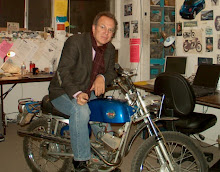.
ATTENTION!
THIS BLOG IS KAPUT!
VISIT: http://askthebiker.wordpress.com/
Over and Out!!!
.
Saturday, October 3, 2009
Thursday, December 11, 2008
Authentic Italian Benelli Multi!!!

Benelli's 250cc four in 1969, its world championship year. Eight- and 16-valve versions were produced, and seven- and eight-speed gearboxes were tried.
Tokyo Nowhere In Sight!!!
Color photos by Wolfgang GruberWednesday, December 10, 2008
Sunday, December 7, 2008
Fabulous Pre-War Supercharged Benelli 4 !!!!
"In the 250cc class, Benelli had enjoyed a successful 1939 season with the normally aspirated single which had propelled Ted Mellors to a rain-lashed TT victory. But in a determined attempt to stay on top of the quarter-liter pile, the Pesaro concern unveiled a new model at the Milan Show late in 1939.
"The sensational Benelli, boasting four cylinders, relied heavily on the single for cycle parts, merely transplating the same elementary frame, girder front forks, plunger rear suspension, 2.75 by 21 inch tyres, tank and so on. But the engine was a revelation. Each cylinder was of 42mm bore by 45mm stroke for a total capacity of 249cc. In the mode made fashionable by the 500cc Gilera, the four cylinders were mounted across the frame but inclined only by 15 degrees. The two valves per cylinder were governed by a dohc assembly with a T-shaped cascade of gears on the right hand side of the engine. An extension ran to the front of the engine to drive the magneto. Water cooling was employed with the radiator mounted on the front down tube, while the oil tank was beneath the saddle.
"The gear driven blower was a Cozette vane type, mounted above the four-speed gearbox. The supercharger employed one carburettor and a compensating lung with generous circular finning. The four exhaust pipes merged into two on either side.
"This fearsome power plant supposedly produced an undreamt of 52bhp at 10,000 rpm, producing a purported top speed of 145mph in GP trim and 155mph in streamlined guise for record attempts.
"Regrettably, the war started before the machine had the opportunity to show its pace on the racetrack. An example survived the devastation inflicted on the Pesaro factory by retreating German armies but, thanks to the FIM ban on supercharging, it was destined never to turn a wheel in anger. Today only an engine remains intact."
--Classic Racer, Winter 1987
Thursday, December 4, 2008
SPOT THE ENGINE: MOTO GUZZIS FOR DUMMIES
In case anyone's forgotten what a real Moto Guzzi looks like, here's a photo of the genuine article (this one goes 153 miles per hour). Look closely at the engine. Memorize it -- the shape, the outline, the contours. That's what a real Moto Guzzi engine looks like. If the motor doesn't look more or less exactly like this one, it's not a real Moto Guzzi, it's some clone or rip-off or de Tomaso-spawned badge-engineered monstrosity. So simple! Now you try it...
BADGE ENGINEERING: 2008 QUIANJIANG QJ125 vs. 1975 MOTO GUZZI 250 TS vs. 1973 BENELLI 250C



At the top, the 2008 Quianjiang (new Chinese owners of Benelli) QJ125-A . In the middle, a 1973 Benelli 250C. At the bottom, a 1975 Moto Guzzi 250 TS. Always on the lookout for bright new ideas, Alejandro de Tomaso saw "Badge Engineering" at work in the (now dead or dying) British and American automotive industries, and brought it to Italy. Hey, Grazia! Think these bikes look somewhat similar? That's what I thought.

Benelli's very first "badge engineered" bike, and its creator -- Alejandro de Tomaso sits atop his new baby, The Benelli 750 Sei.
Renzo Pasolini Races 500cc Benelli Four at the 1967 TT
Subscribe to:
Posts (Atom)







